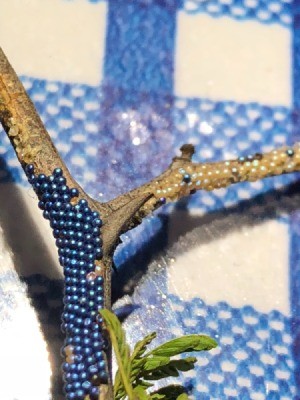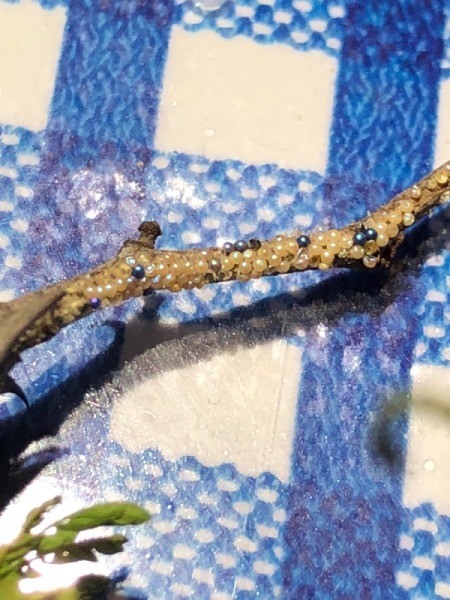
Pghgirl40
Bronze Feedback Medal for All Time! 196 Feedbacks July 9, 20180 found this helpful
If they are both the blue black and the yellow, that may be cutworms:
www.google.com/search?client=firefox-b-1&tbm=isch...
They are quite repulsive and the most natural way (and one the creeps me out the most) way to get rid of them is to hand (gloved) pick them off and drop them in a cup of soapy water.
There are lots of other solutions but because we have a dog and small children neighbors, I don't do the chemical ones.
This is is a good resource:
www.almanac.com/.../cutworms
Good luck! Sorry you are dealing with this!

July 12, 20180 found this helpful
What you have on your plant is Cinnabar moth eggs.
- This is a very interesting subject and probably not well known unless you live in an area that has cultivated the Cinnabar moth to eradicate the very harmful ragwort weed. Oregon and Washington seem to have been the first US states to use them on a wide scale basis but the UK and other parts of Europe use the Cinnabar moth also.
- You do not say where you live but perhaps it is in one of these areas?
- The problem seems to be that no one really researched what to do with these moths when/if they started laying eggs on "good" plants.
- Here is a statement from a university site:
- I don't believe much thought has yet gone into methods for controlling the moths when they devour non-target plants. I would guess that you could attempt to look for eggs and remove them manually, or, attempt to control the larvae of the cinnabar moth (Tyria jacobaeae). We can't recommend pesticides as we are librarians and not licensed pesticide handlers, but you might investigate whether something like Btk (Bacillus thuringiensis kurstaki) is registered for controlling moths in their larval stage. Oregon Health Authority has information about Btk's use on gypsy moth. This should give you an idea of how Btk works.
- Here is another statement from Oregon agriculture department:
- "In 1976, the Oregon Department of Agriculture declared tansy ragwort a noxious weed. In the meantime, researchers were searching the original home of tansy ragwort, Europe, for biological control agents. Cinnabar moth was one of three natural enemies released to control the weed. It was first released in the 60's with additional releases thereafter.
- The grayish-black moths with red patches on the wings established and provide biological control of this weed.
- The moths lay their eggs on the underside of the leaves of tansy during the late spring. Soon small orange and black caterpillars hatch from the eggs. They feed first on the lower side of the leaves on which the eggs were laid, then move onto the developing flower buds and leaves. They pupate on the ground in the leaf litter. There is one generation a year."
- "Caterpillars are feeding from July early September and are initially pale yellow but soon develop bright yellow and black stripes to deter predators.
- The caterpillars feed on poisonous ragwort leaves. The poison from the leaves is stored in the caterpillars body (and even remains when they are an adult moth). Any birds or other predators that ignore the caterpillars bright warning sign will be repulsed by how foul they taste."
- www.google.com/search?q=moth+eggs+on+plants&client...:
- lightlyenchanted.blogspot.com/.../30-days-wild-day-17.html
- www.arkive.org/.../
- oregonstate.edu/.../cinnabar_moth.html
- Finally:
- www.buglife.org.uk/.../cinnabar-moth
- I do not know what type of plant you have but I believe you should contact your Agriculture Agency/Extension Office and send them your photos and ask for their help in how to take care of these moths.
- In the US:
- www.gardeningknowhow.com/.../what-is-extension-service.htm
- If you are in another country you should have a similar office/agency.
Additional information:
depts.washington.edu/.../resource_search.php?term=2611
 Can anyone tell me what kind of bug eggs these are?
Can anyone tell me what kind of bug eggs these are?